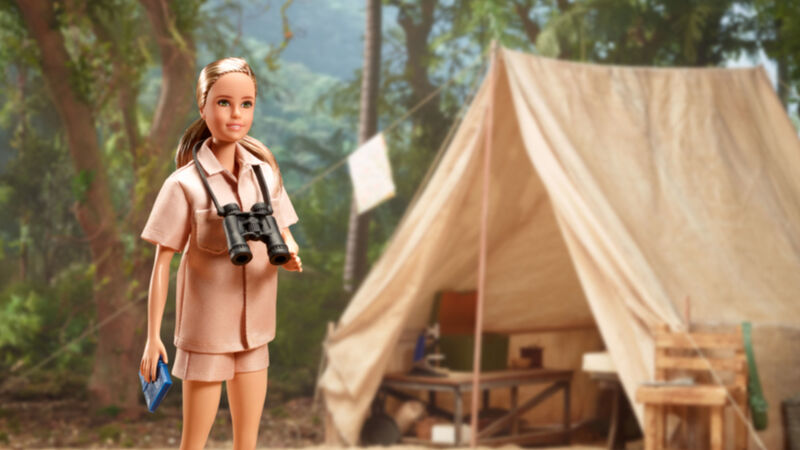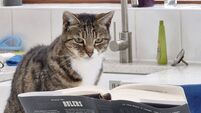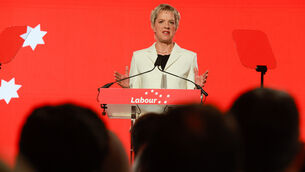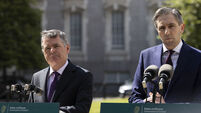Clodagh Finn: Is Barbie now a feminist icon?

The only shame is the doll is Goodall as a younger woman.
OURS was a Sindy household and I have never owned a Barbie, but if ever there was a time when I felt compelled to buy one, it is now.
The world-famous Mattel brand has just launched a Dr Jane Goodall doll celebrating the life and work of the renowned primatologist. It comes with excellent accessories: A set of binoculars, a tent, and a model of David Greybeard, the first chimpanzee to trust the scientist at Gombe National Park in Tanzania.
Goodall went there in the 1960s equipped with a notebook and a set of binoculars, just like her doll, and went on to do pioneering research that changed the way we think not only about animals but what it means to be human. Goodall’s discovery that chimps made and used tools challenged the belief that tool-making was the defining trait of humans.
There was much more. She observed that chimps had individual personalities and showed compassion towards each other. And she proved that chimps were not herbivores as she saw them hunting and eating meat.
Earlier this month, when Mattel launched the Dr Jane Goodall Barbie, the woman herself was delighted. She said her own dream had been supported by her mother, but there hadn’t been any female role models when she was growing up in the UK. Dr Dolittle and Tarzan were her heroes.
Too often, girls’ toys are “girly, girly, frilly, frilly”, as Goodall said in one of many refreshing interviews. “Through this partnership, I hope to inspire the next generation of eco-leaders to join me in protecting our planet and remind them they can be anything, anywhere — on the field, in the lab, and at the table.”

My only regret is that Mattel has produced a doll of Goodall as a younger woman. I’d love to see the brand issue one of her as she is now, an 88-year-old force of nature who continues to raise awareness about the importance of conservation.
All the same, what a welcome change from the Barbie of yore who was so impossibly proportioned that she could not have walked upright if she were a real women. How can a little girl be anything — always a Barbie philosophy — with a BMI of 16, a 39” bust, an 18” waist, and size 3 stilettos?
It is actually inspiring to see Barbie’s Inspiring Women series, which “pays tribute to courageous women who took risks, changed rules, and paved the way for generations to dream bigger than ever before”.
Among the famous names in its pantheon, you’ll find poet and civil rights activist Dr Maya Angelou, tennis star Billie Jean King, jazz legend Ella Fitzgerald, artist Frida Kahlo, and disability rights activist Helen Keller. It’s heartening, too, to see hosts of other women — from CEOs to hammer-throwers, astronauts to engineers — represented in doll form (with slightly more realistic body shapes).
The doll with a bulging waistline and cellulite might still be some way off, but it is good to see a global brand respond to an increasing desire to give young girls (boys too) diverse role models, past and present.
On its website, Mattel explains that it has been doing that since 2015, in part responding to its own online survey which found that 81% of mothers were worried about their daughters’ role models.
Even if it is marketing-speak, it is noteworthy when a multinational starts talking about shining a light on the women who break boundaries in their fields so that they might inspire the next generation.
Could it be that Barbie, all 11.5in of her now carbon-neutral form, is becoming a feminist icon by stealth?
It’s almost radical to introduce a child to the range of possibilities that are now represented by Barbie dolls.
Let’s hope Irish Barbie is going to get a bit of a makeover in the future too. I came across an Irish dancer doll with her own passport and a few others inspired by myths and legends, but wouldn’t it be something to see, say, Olympian Kellie Harrington as a Barbie, with her say-so, of course?
Or Jocelyn Bell Burnell, the astrophysicist from Armagh who discovered the first radio pulsars as a graduate student in 1967, work that went on to win her supervisor a Nobel Prize. Since then, she has made a point of helping other women, minorities, and refugees study and conduct research.

Speaking of astrophysics, I’d love to see a Margaret Huggins doll in honour of a woman who did pioneering work in what was, in 1873, the new field of astronomical spectroscopy. I also found it amazing that this woman born in Dublin in 1848 was a regular visitor to telescope-maker Howard Grubb in Rathmines.
(As an aside, the fact there was an internationally acclaimed telescope-maker in Rathmines is a matter of interest. The Grubb Company made periscopes for the Royal Navy and famously built the Great Melbourne Telescope which was installed in Melbourne in 1869. In Rathmines, the suitably named Observatory Lane commemorates the site of the factory.)
To return to the theme of dolls as female role models, there are any number of Irish women who might be celebrated. What of Kathleen O’Rourke, a co-founder of the Central Remedial Clinic, an early advocate of antenatal care, and the woman who set up the first mass keep-fit organisation in Ireland?
Fashion designer Sybil Connolly also offers wonderful doll accessory possibilities as does Countess Markievicz, though I’d argue against one of her in uniform with a revolver. How can we argue that children learn through play and then give them toy guns?
Back in Barbieland, the possibilities might be endless but it’s too early to proclaim Barbie herself as a stereotype-busting role model. There has been much speculation about the new Barbie movie due for release next summer. It is a risky venture, as previous failed attempts to bring the famous doll to the screen have shown.
Earlier this year, comic and actor Amy Schumer said she dropped out of a 2016 project because when she tried to make Barbie an inventor in her script, she was told to make her an inventor of jelly stilettos.
The first stills from the upcoming movie aren’t exactly encouraging either. They show the titular heroine (Margot Robbie) dressed in fluorescent pinks and purples, alongside Ken (Ryan Gosling), with ripped torso and bleached hair.
They are both Barbie-style perfect but Barbie herself is forced out of Barbieland due to her imperfections. She sets off on an adventure in the real world where she discovers that perfection comes from within.
If that sounds disappointing — and it really does — the only hope is that in the hands of writer and director Greta Gerwig (who gave us Lady Bird with Saoirse Ronan), it will break out of the mould.
Now that we have started if not quite to break but expand the mould, it would be so disappointing to put Barbie back in her box.












